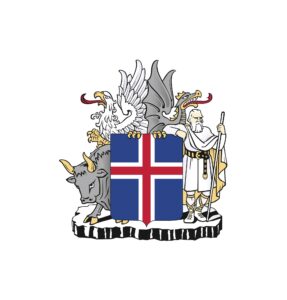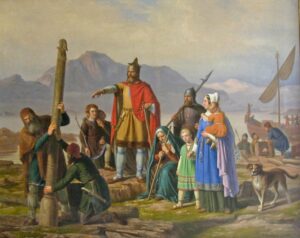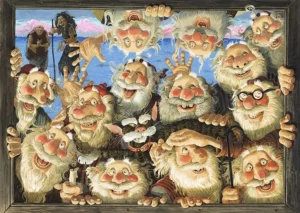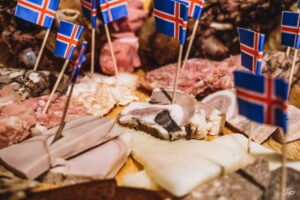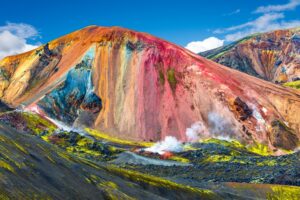Geology
Iceland is an island in the north of the Atlantic ocean. It is 102.775 km2 .
The oldest part of Iceland is about 16 000 000 years old. The country is located on the border of the Eurasian plate and the North American plate. Underneath the country is a hot spot, which means that the mantle underneath the Earth’s crust is hotter than it is on average. There are several hot spots on the earth, but the one underneath Iceland is the most active. There are more than 30 active volcanic mountains in Iceland and in fact, there is a volcano going on right now near Reykjavík, the capital city. The biggest glacier in Europe, Vatnajökull, is also located in Iceland. The hot spot is placed underneath the glacier. Iceland is one of two places in the world where you can see the borders of two oceanic plates over sea level. The borders are near Þingvellir, where the Alþingi took place in the olden days.
Population
The total population of Iceland is approximately 370.000. The population has increased to a little less than 5000 in the last year. 64% of the population lives in Reykjavík and its vicinity.
Industry
The main industries of Iceland are the fishing industry, tourism, and agriculture. In olden days the agriculture and the fishing industry were the only jobs you could get. In the last couple of years tourism has grown and is now a big part of Icelandic industry.
History of Iceland
Settlement in Iceland started in the Viking Age. The first person who settled in Iceland was from Norway; Ingólfur Arnarson, who entered the country in 874. In the following years, more and more people settled in Iceland. The settlement period lasted from about 874 to 930. Those events are written in two ancient manuscripts, Landnámabók (The Book of Settlement), and Íslendingabók (The book of the Icelanders), both written in the 12th century.
The official language of Iceland is Icelandic. Icelandic is similar to Norwegian, Danish, Faroese, and Swedish. That is because all of those languages have the same origin; Old Norse. Icelandic has developed less than the other nordic languages which makes it relatively easy for Icelanders to understand manuscripts written in Old Norse.
Originally, Icelanders believed in the Nordic gods, and some still do. In the year 1000, the official religion changed to Roman Catholic. In the year 1550, it changed to Lutheran Christianity. One of the bishops, Jón Arason, did not want Icelanders to change their religion, so his head was cut off.
The national sport of Iceland is called glíma, which is a form of wrestling, founded by the Vikings.
Alþingi, or Althing, was founded in 930 at Þingvellir (or assembly fields). It is still the national parliament and is the oldest surviving parliament in the world.
Iceland has been under both Danish and Norwegian rule. However, in 1918 Iceland became a sovereign state with its own national flag but remained in royal union with Denmark. Alþingi was given unchallenged legislative power, but Denmark took care of foreign affairs and coastguard. A republic was established at Þingvellir on June 17th, 1944, and Iceland‘s relationship with Denmark fell completely. Sveinn Björnsson was elected the first president of Iceland.
Icelandic culture
Names in Iceland
Family members usually don´t have the same last name. When giving a kid a last name people usually take the first name of the kid´s father (or mother) and add „son“ (e. son) or „dóttir“ (e. daughter) to the end of it, depending on the kid´s gender. People‘s last names usually mean „The son of [father´s name]“ or „The daughter of [father´s name].“
People usually don´t give their babies names right after they are born but they have to give them names before they turn six months old.
Christmas in Iceland
In Iceland, people don´t believe in the same Santa Claus as people in some other countries. In Iceland, there are thirteen Santas. They are called „jólasveinarnir“ or like they say in English,‘‘the yule lads“. Thirteen days before Christmas, kids put a shoe in their window and leave it there overnight. Then the first yule lad, Stekkjarstaur, puts a present in the shoe while the kid sleeps. Then every night until Christmas, the yule lads arrive, one by one, every one of them leaving a present in the shoe in the window. But if kids don´t behave well, they might get a potato in their shoe instead of a present as a punishment. The yule lads live in a cave up in the mountains in Iceland with their parents, Grýla and Leppalúði, and their cat. People in Iceland open their Christmas presents on Christmas Eve. There are a lot of stories and myths about the yule lads and their family. Some of them have been used to scare children.
Icelandic literature
The language spoken in Iceland is Icelandic. Icelanders have been known for writing a lot. One in ten Icelanders publishes a book in their lifetime. There are many old books in Iceland. Some of them are called „Íslendingasögur“ (e. Sagas of Icelanders). They were written in the 1200s and the 1300a and are about Icelandic men who lived in the years 930 – 1030. It is believed that those stories were passed down from generation to generation for many years before someone decided to write them down. Because of that, people don´t know exactly how true these stories are. Some of them are quite unbelievable and the stories probably became less accurate every time someone told them, so one can imagine how much the stories changed before they were written down. The authors propably also had to fill in many gaps in the stories and they maybe even changed them on purpose. There are about 40 of those stories in Iceland and they are mostly about honor, conflicts between people, murders and revenge.
Verslunarmannahelgin
The weekend before the first Monday in August is called Verlunarmannahelgin. On that weekend there are many festivals held all around the country and it is one of the biggest travel weekends in Iceland. An example of festivals held in Iceland on that weekend are „Þjóðhátíð,“ which is held in Vestmannaeyjar, „Ein með öllu“ which is held in Akureyri, and many more. Unglingalandsmótið is also held on that weekend. Unglingalandsmótið is a competition where teenagers can compete in many different activities. The competition is held in a different town every year.
Famous Icelanders
Halldór Laxness
Halldór Laxness was an Icelandic writer. He was born in 1902 and in 1955 he won a Nobel prize in literature, becoming the only Icelander to ever win a Nobel prize. He was seventeen years old when his first book, Barn náttúrunnar, came out. He also wrote books called Salka Valka, Sjálfstætt fólk, Gerpla, and more.
Stefán Karl Stefánsson
Stefán Karl Stefánson was an Icelandic actor best known for his role as Robbie rotten in Lazy Town. He died of cancer in 2018.
Vigdís Finnbogadóttir.
Vigdís Finnbogadóttir was the first female democratically elected president in the world. She was born in 1930 and became the president of Iceland in 1980. She was a president for 16 years.
Cuisine
Icelandic cuisine has been described as both the most disgusting in the world and the healthiest in the world. Traditional Icelandic dishes are for example black pudding, burnt sheep heads, skyr, flatbread, rye bread, and hung, smoked, meat, dried fish (harðfiskur), lýsi (cod liver oil), and all sorts of sour foods. The reason for the sour food is that by storing food in whey, it stays edible for a long time. Icelanders had to keep the food edible during the winter. Every year in January, there is a celebration called þorri. During þorri, we eat traditional sour food to honor our ancestors who ate the food all winter long. The dishes are jam, or jello, made from burnt sheep heads or pork, sour black pudding, fermented shark (it is hung up until it rots), cured rolls of lamb flank, sour whalefat, dried fish with butter, and sour ram balls. The day before Christmas Eve, it is traditional to eat either salted cod or fermented ray. This is a tradition because, on Christmas Eve, people ate good food like lamb meat, so the day before all the Christmas celebrations, people would eat food that was not as good and expensive as the Christmas food. Icelandic beverages are landi (home-distilled liquor), brennivín (aquavitae), whey, and of course the Icelandic water. Another thing that is traditional in Iceland is cocktail sauce. We eat it with for example pizza and french fries. It is made of low-fat milk, mayonnaise, ketchup, and some spices if preferred. Icelanders eat a lot of skyr, which is basically thick yogurt, high in protein but low in fat. It is eaten as a snack or as a meal and is very popular because it is bought ready to serve. There are many taste varieties and it keeps you full for a long time. Höfn is often called The Lobster Town. The fishermen here catch a lot of lobster and it is available in almost every single restaurant in Höfn. In recent years, the catch has reduced and it has not been allowed to fish for lobster. Last but not least, the Icelandic hot dogs are often considered the best in the world.
Beautiful places
Icelandic nature is delicate, spectacular, and diverse. Iceland is one of the most active volcanic areas on earth. The landscape is shaped by fire, ice, water, and winds. The country’s wilderness is characterized by its large barren open areas. Only a fourth of the island is vegetated. The ecosystem in Iceland is considered to be quite fragile and over the year there has been a problem with soil erosion in some parts of the country. One of the things Iceland is most famous for are its glaciers. Another thing Iceland is well known for is the lack of high trees. There is a joke in Iceland about our forests. It goes like this. What do you do if you get lost in an Icelandic forest? You stand up.
There are many beautiful places in Iceland and the landscape is very dramatic. If we were to tell you about them all it would take days. So, we are just going to tell you about a few of them. All of the places mentioned here are outside of the municipality of Höfn.
Skógafoss is a 60-meter-high waterfall in the south of Iceland. Reynisfjara is called the black beach by the tourist it is located near a town called Vík. On the beach, there are beautiful basalt columns. The beach is considered to be very dangerous because of high waves. Landmannalaugar is a big place in the highlands. It is known for beautiful colors and hot springs where people can bathe. Lake Mývatn is an area in the north part of Iceland. It is known for its variety of birds. The geological formation is memorable. The area is geothermal and very volcanically active. Bláa lónið, better known as the Blue Lagoon is a geothermal spa that´s situated on an 800-year-old-lava field on the Reykjanes peninsula.
Written by Anna Lára, Selma Ýr and Stígur
Facts about Iceland – presentation
Bibliography
History
https://www.britannica.com/place/Iceland
https://is.wikipedia.org/wiki/Saga_%C3%8Dslands
https://en.wikipedia.org/wiki/Althing
Geology
http://www.islenskeldfjoll.is/
https://www.mbl.is/greinasafn/grein/1543910/
Famous Icelanders
https://www.forlagid.is/hofundar/halldor-laxness/
https://icelandmag.is/article/10-world-famous-icelanders-do-you-know-any-them
Icelandic literature
https://www.visindavefur.is/svar.php?id=6476
https://www.bbc.com/news/magazine-24399599
Population
https://px.hagstofa.is/pxis/pxweb/is/Ibuar/Ibuarmannfjoldi2byggdirByggdakjarnar/MAN030101.px?fbclid=IwAR2x7gXnUk3oKUfQELNHBBadqqrkb71aWLzpv82sQBH6pvkCdn9KfDp1A60
Beautiful Places
https://en.ni.is/florafunga/vegetation?fbclid=IwAR1DXB5qwxvwYRo9JaNtdPkQ2P8ZuNHe6yxaeVeC4aXaQQH9J8P5wOyvAaQ

